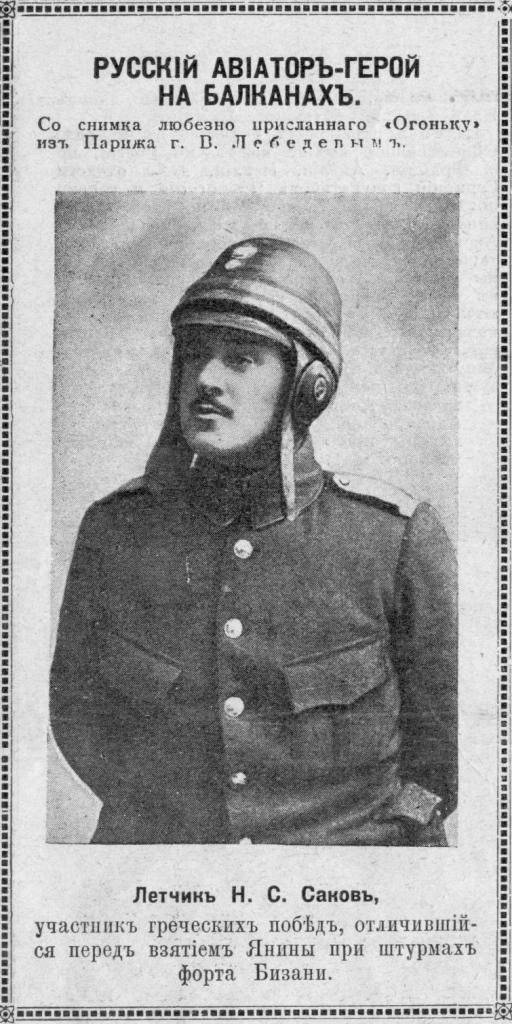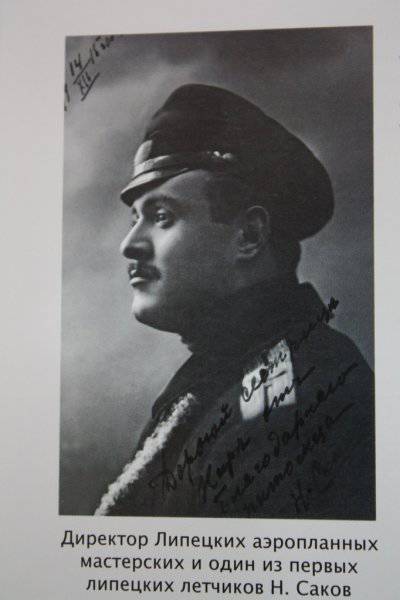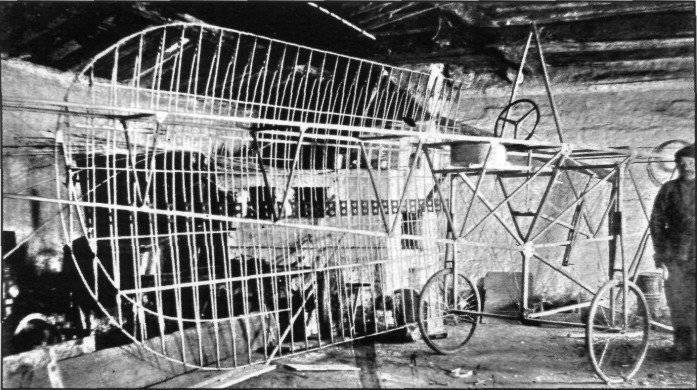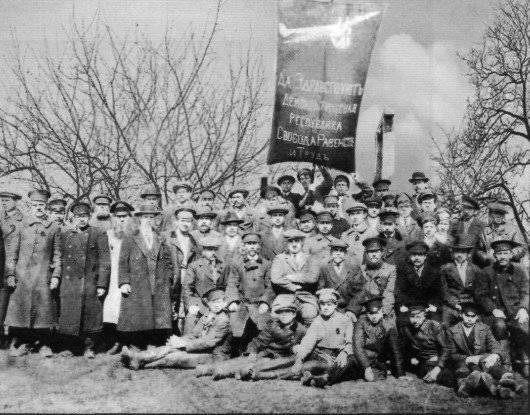The first aviator of Lipetsk
Unfortunately, domestic fans of aviation, as they called it a new kind of human activity, at that time had to be content only with newspaper clippings about regular records. The situation changed only at the beginning of 1910, after the most talented student of Farman, from Odessa Mikhail Efimov, beat Orville Wright's achievement in flight duration with the passenger. After that, as if waking up, the Russian Empire quickly began to catch up. In many large cities of our country public flights triumphantly took place. Throughout the year, the first domestic pilots — Efimov, Vasilyev, Popov, Zaikin, Utochkin and others — demonstrated their talents in conquering the airspace. By the end of 1910, more than three dozen Russian pilots had already become happy owners of pilot diplomas received in France.
Domestic developers also did not remain in debt. At the end of spring 1910 year, Prince Alexander Kudashev in Kiev built the first domestic aircraft of the original design, equipped with a gasoline engine, and in June an airplane of the future world-famous aircraft designer and philosopher, Igor Sikorsky, who was still a student, took off. Pilot schools were organized in Gatchina and Sevastopol. The main achievement of domestic scientists is considered to be the development in the 1911 of the year by Yakov Modestovich Gakkel of an airplane fuselage type, which determined the appearance of all subsequent models.
 Back in June 1908, four years before Nicholas II approved the financing order aviation of detachments, considered the date of birth of the Air Force of our country, in Lipetsk, donations were collected for the purchase and construction of balloons, as well as controlled airplanes and other aircraft of the Imperial All-Russian Aeroclub. This day is considered the beginning of aviation stories the city, which Lipetsk is justly proud of. In the flight units located on the land of Lipetsk, many famous pilots and prominent cosmonauts lived and studied. However, for a very long time, the identity of the first aviator of the Tambov province, into which Lipetsk was a member until the end of the twenties of the last century, remained unknown. They were local native Nikolai Stakovich Sakov, who in September 1911 of the year, having passed all the necessary exams at a French flying club, received a pilot certificate with the number 627. For more than ninety years, the life of this man, like his name, has been consigned to oblivion. The reasons for this are quite clear, since during the civil war the pilot supported the white movement. The traitors had no place in the modern history of our Motherland, and therefore too much of his biography was lost and destroyed. But even the few facts of the short but bright life of Nikolai Sakov deserve to be heard.
Back in June 1908, four years before Nicholas II approved the financing order aviation of detachments, considered the date of birth of the Air Force of our country, in Lipetsk, donations were collected for the purchase and construction of balloons, as well as controlled airplanes and other aircraft of the Imperial All-Russian Aeroclub. This day is considered the beginning of aviation stories the city, which Lipetsk is justly proud of. In the flight units located on the land of Lipetsk, many famous pilots and prominent cosmonauts lived and studied. However, for a very long time, the identity of the first aviator of the Tambov province, into which Lipetsk was a member until the end of the twenties of the last century, remained unknown. They were local native Nikolai Stakovich Sakov, who in September 1911 of the year, having passed all the necessary exams at a French flying club, received a pilot certificate with the number 627. For more than ninety years, the life of this man, like his name, has been consigned to oblivion. The reasons for this are quite clear, since during the civil war the pilot supported the white movement. The traitors had no place in the modern history of our Motherland, and therefore too much of his biography was lost and destroyed. But even the few facts of the short but bright life of Nikolai Sakov deserve to be heard.His father, a Greek by nationality, was called Sakov Stavr Elevterevich. In 1888, in the capital of Russia, he married Anna Nikolaevna Fedtsova, who was the daughter of a retired lieutenant from a noble family. His wife was from Lipetsk, and the newlyweds, living in Moscow, regularly came here in the summer. They had a beautiful wooden house on Dvoryanskaya Street (after the revolution - Lenin Street) and a small estate near Gryazi Station. Here in Lipetsk, Anna Nikolaevna and Stavr Elevterievich had two sons - Nikolay and Alexander.
The eldest son, Nikolai Stavrovich Sakov, was born on July 29 of the 1889 year. He spent his childhood in Moscow and Lipetsk. In the 1902 year, the nobility of the Tambov province was granted to their family, and his father got a job as a doctor at the prestigious Lipetsk Mineral Water resort. In the 1908 year, Stavr Yelevterevich finally stopped teaching practice and decided to devote himself entirely to medicine. Soon he, along with his wife and children, finally moved to Lipetsk.
Here, unfortunately, the first white spot in the biography of the Lipetsk pilot should be noted. It is not known for certain where and how Nikolai Sakov studied, what profession he received. However, stories about the first flights conquered his young heart, and in 1911, he collected his belongings and received the blessing of his parents, and went to France to the famous flight school of Armand Depperdussen. The school was founded in a picturesque place called Bateny, which is near Reims. Wide local fields and plains have long been chosen by the French military, who regularly organized here maneuvers and troop inspections. And in the 1909 year, airmen and aeronauts organized here one of the first airfields in the world, where new personnel could be trained, and international competitions in flight skills were regularly held. The hero of our story was trained under the guidance of the most experienced instructor pilot Maurice Prevost, and already in the beginning of autumn he received a diploma and a flight certificate in the name of Nicholas de Sacoff, as he was called in France. Before returning home, he bought himself a new Deperdussen-type monoplane in the French firm SPAD. There is evidence of the demonstration flights of the young pilot, which took place on the Khodynka field, and at the beginning of 1912 of the year, Nikolai Sakov reached his native Lipetsk.
According to the documentary evidence presented in the form of a note in Kozlovskaya Gazeta, released on 13 on May 1912 in Kozlov (now Michurinsk), Nikolai made his first home flight on May 6 near the village of Shekhman. The Sakova aircraft is described as a fifty-strong five-pound airplane weighing approximately (approximately 82 kilograms). The take-off was successful, but at the height of twenty sazhens (43 meters) the propeller blade broke off near the airplane. The plane crashed to the ground and crashed, but, fortunately, the pilot got off with only minor injuries. The remains of the airplane were sent to a local machine shop for repairs. The flight was considered unsuccessful and quickly forgotten about it, especially since at the end of May another more eminent Russian pilot Boris Iliodorovich Rossinsky performed at the Lipetsk hippodrome. The “grandfather of the Russian aviation” on the racing aircraft “Blerio” successfully flew off its program and remembered a resident of the city, of course, much stronger than Nikolai Sakov.
By the end of 1912, the public flights of the first pilots began to cease. Aviation was becoming a serious occupation, and it didn’t need such circus tent tours. In addition, it practically did not bring material benefits to the pilots. Revenues from ticket sales went to rent the runway (for which racetracks were often used), gasoline, and aircraft recovery from accidents, which, it should be noted, were not uncommon. And in September 1912, the anti-Turkish war in the Balkans began. In an effort to liberate the peninsula from the yoke of the Ottoman Empire, the countries of the Balkan Union for the first time used airplanes for military purposes. At this time, Nikolai Stavrovich Sakov committed an unexpected act for many - went to this war to fight in the ranks of the young Greek Air Force. Such behavior did not go unnoticed, and in a number of Western literature Sakov is mentioned precisely as the first hired pilot in history, fighting on the side of Greece. However, here we should not forget about who was the father of Nicholas. Stavr Yelevterevich was always proud of his Greek roots and, being a man of extremely educated, raised his son in the spirit of if not love, then at least respect for the historical homeland.
 Let's leave it on the conscience of historians to understand whether patriotic feelings or thirst for profit pushed Nikolai Sakov to such an act, but the fact remains that by the end of September he arrived at the disposal of the only Greek aviation unit located at the airfield near the town of Larissa and numbering sixty-three people. Already five of them (including Nikolai) were pilots, the rest were part of the ground staff. The pilots were armed with one of the most popular aircraft of the time — Farman type aircraft. Since the beginning of October, the valiant aviation of Greece has begun to carry out its combat missions. The pilots conducted aerial reconnaissance, and periodically dropped hand grenades on Turkish positions. The Turks did not want to put up with it, and very often the “Farmans” traveled to their airfield with numerous holes in the wings from bullets. Sometimes the damage was so severe that it led to forced landings.
Let's leave it on the conscience of historians to understand whether patriotic feelings or thirst for profit pushed Nikolai Sakov to such an act, but the fact remains that by the end of September he arrived at the disposal of the only Greek aviation unit located at the airfield near the town of Larissa and numbering sixty-three people. Already five of them (including Nikolai) were pilots, the rest were part of the ground staff. The pilots were armed with one of the most popular aircraft of the time — Farman type aircraft. Since the beginning of October, the valiant aviation of Greece has begun to carry out its combat missions. The pilots conducted aerial reconnaissance, and periodically dropped hand grenades on Turkish positions. The Turks did not want to put up with it, and very often the “Farmans” traveled to their airfield with numerous holes in the wings from bullets. Sometimes the damage was so severe that it led to forced landings.In December, the “air squadron” was transferred to an airfield not far from the Greek city of Preveza and began to work another area of the front with grenades, in particular, the capital of Epirus, Ioannina, besieged by the Turks. Here the pilots have mastered another very useful function of aircraft. They began to dump the residents of the newspaper and leaflets, as well as parcels of food and medicine. The parcels of modest size were designed not so much to help the suffering as to support their morale. It was one of the first, recorded in the history, air ways of helping the surrounded troops. Nikolai Sakov took direct part in this good work. Also, there was information about his suicide attack by Turkish troops located in Fort Bizani. The fired from the ground pilot successfully threw two bombs, after which he tried to get to Prevez on a riddled plane. However, the motor stopped, and Nikolai barely reached his, that is, Greek, positions. Having landed the plane abnormally, the resourceful aviator repaired the engine and managed to take off again.
The domestic press also wrote about the military exploits of our pilot. Thanks to the remaining newspaper and magazine clippings, it was possible to recover many facts from his biography. For example, on January 13 of the year 1913 in the Iskra almanac, a small note with a photo entitled “Russian Aviator Nikolai Stavrovich Sakov in the service in the Greek Army” was devoted to him. Magazine "Spark" 28 April 1913 year published a portrait of a young pilot in uniform. The picture was called: “Russian pilot - Balkan hero” and was sent to the editorial office from Paris by one Lebedev. In the journal, Sakov was named a participant in the Greek victories, who distinguished himself in the battles for Yanina and the storming of Fort Bizani.
After the war, Nicholas returned to Russia. In 1913-1914's, the overripe pilot trained young cadres in the Imperial All-Russian Aeroclub as an instructor pilot. At the beginning of 1914, the wedding of Nikolay Sakov and Nina Sergeyevna Bekhteyeva, a native of an old noble family, took place. The celebration took place in the northern capital, and a year later they had a son, named Alexander.
Everything was going great in the life of Nikolai Sakov, until a new, already world, war began. All the pilots of the Imperial All-Russian Aeroclub voluntarily-compulsorily organized a Special Aviation Squad (later renamed the thirty-fourth corps), which hastily transferred to the battle area near Warsaw. In early September, 1914 began the first combat missions.
The squad at the time of creation included six pilots, the same number of aircraft and vehicles, as well as one marching workshop and a mobile meteorological station. The commander was Nikolai Aleksandrovich Yatsuk, who remained the head of the squadron until October 1917. It was a bright, extraordinary person who laid the foundations for the combat use of aircraft. Nikolai Stavrovich Sakov became a member of the squad as a “pilot-hunter” and in the first battles he proved himself to be a skilled and fearless pilot. It was a battle experience acquired in Greece. 23 on April 1915 of the year he was awarded the fourth degree St George Cross for a series of successful aerial reconnaissance under enemy fire from 1 September of 1914 to February 1 of 1915. And on July 16 of 1915, he received George of the third degree because under enemy gunfire from 12 to 22 of April he performed a number of aerial reconnaissance and bombings on the trains and the Augustów railway station. Of course, Nikolai was not invulnerable. In the autumn of 1914, enemy bullets reached their goal, and Sakov spent a month in the Red Cross hospital in Minsk.
Obviously, so could Nikolay Sakov tell about his reconnaissance missions.
In 1916, Sakov received the rank of ensign for military merits. Of the thirty-fourth aviation detachment, he moved to the seventh army. For a number of unknown reasons (perhaps these were health problems) at the same time, he was losing interest in military service. He has an idea to create his own aircraft manufacturing enterprise. To help in this important undertaking, he turns to his father, who in the spring of 1916 concludes an agreement with the Air Force Office fleet Russian Empire for the supply of training aircraft. By the summer, using his many connections, Stavr Elevterievich organizes a partnership in Lipetsk called “Lipetsk Airplane Workshops”. The main creditors were the well-known industrialists Khrennikov and Bykhanov in the city.
The company was located on the Living Street (now Internatsionalnaya) and consisted of a whole complex of workshops with a total area of more than two and a half thousand square meters. These included metalwork, carpentry, paint, blacksmith, assembly, oxygen-welding, foundry and drying department. The total number of workers reached seventy people. 8 November 1916-th Stavr Sakov, who had become a state adviser by that time, officially signed a contract with the Office of the Military Air Fleet to supply five training monoplanes of the Moran-F type in the first month of 1917. And on November 18 he transferred all the rights to the partnership and, accordingly, his contractual obligations to his son Nicholas, who left military service by that time.
Here it is necessary to make a digression and note that by this time (the end of 1916), our country was in the war for the third year. The end of hostilities was not even visible on the horizon, and the country's industry was in a deplorable state. There was no possibility to predict and even more in time to ensure the supply of even the most necessary materials in the production of materials (screws, nails, wire). In addition, revolutionary sentiments that were in the air of the working environment also did not contribute to normal production.

Due to the prevailing circumstances, the agreement had to be postponed twice, until finally, on November 23 of 1917, it was finally terminated by representatives of the Office of the Military Air Fleet. In the spring of 1918, the Lipetsk Aircraft Workshops were transferred to the county Council of the National Economy, which completed the construction of five airplanes and sent them to Moscow, after which the organization ceased to exist.
The further life of Nikolai Sakov cannot be called neither easy nor carefree. It seemed that luck had completely turned away from this man. When the Civil War began, he joined the ranks of the White movement. Condemn him for the fact that he, being a consistent monarchist, decided to adopt such a position is impossible. It was his choice, for which Nicholas had to pay the rest of his life.
A number of documents have been preserved indicating that in the 1919 year, Sakov was sent to the UK to buy new airplanes there. The command of the Volunteer Army appreciated the rare combination of a great combat experience with the knowledge of an aircraft builder. After the army of General Yudenich won a number of victories in the attack on Petrograd, the government of Misty Albion agreed to support the White forces in October 18 of 1919. weapons and ammunition. Among other things, to help the dying Russian Empire, it was decided to create an entire aviation division consisting of eighteen airplanes. And, of course, Nikolai Sakov signed up as one of the first volunteer pilots.
On November 1, he arrived in Tallinn, where he was included in the Northwestern Army Aviation Unit Yudenich. Here he served under the leadership of the ace of the first world Boris Sergievsky. However, the pilots promised by the British did not wait, and the squadron’s own aviation equipment was so miserable that the pilots could do nothing to help the common cause. When the troops of the North-Western Army were defeated and driven back to the territory of Estonia, the pilots were sent to the front line as soldiers. In January, the 1920-th aviation squad was disbanded.
Having lost his homeland forever, the thirty-year-old Nikolai Stavrovich Sakov went to Greece again. This country was in a state of another armed conflict with Turkey. He was not mistaken, judging that his services could be useful here. For former services, King Constantine made Nicholas his personal pilot. However, this did not help Greece win the war, it ended in its complete defeat by the fall of 1922. Constantine was overthrown, and the vacated throne was taken by his son, George. Sakov was again on the run.

During this time period, the main part of the Russian émigrés settled in France, yesterday's nobles, aristocrats and officers, having squandered their capital, arranged for any work in order to survive. Soon Sakov, together with his brother Alexander, appeared in Paris. And after a while they could be seen driving a taxi. This is how the most experienced pilots of our country earned their daily bread.
For a long time, the brothers sincerely believed in the possibility of revenge and the restoration of the monarchy in Russia. In order to preserve the military personnel, the brothers participated in the creation, and then the active activities of the Union of Russian Aviators in France. One of the last achievements of Nikolai Sakov was the installation of the icon-monument dedicated to the Russian air fleet. It was made in the late twenties of the last century and consisted of icons of the Most Holy Theotokos, St. George and the Prophet Elijah. Triptych, it was decided to put in the Paris Cathedral of Alexander Nevsky. Nikolai Stavrovich independently compiled a list of all the dead Russian aviators for inclusion in the synodic. However, he did not have time to finish the work. In February, 1930, he died and was buried in the cemetery of Russian émigrés of Saint-Genevieve-des-Bois. Completed the work begun, Alexander.
After the death of Sakov, his wife and son, who accompanied him in all the wanderings, moved to Nice, and in 1938, to Italy. To raise a child, Nina Sergeevna had to care for the sick and the elderly, to work as a nurse. In 1945 in Rome, he became the head of the Russian tea house and died in 1955 in the year. Their only son, Alexander, graduated from the University of Rome, became a renowned economist and public figure. The grandchildren and great-grandchildren of Nikolai Sakova currently live in Italy and Germany. Unfortunately, it is not known whether they know anything about who their ancestors were ...
Information sources:
-http: //ru.wikipedia.org/wiki/
-http: //ser-sarajkin.narod2.ru/ALL_OUT/AiKOut10/SakovNS/SakovNS001.htm
-http: //www.michpravda.ru/articles/pervyy-tambovskiy-lyotchik-6500
-http: //www.lpgzt.ru/aticle/24943.htm
Information